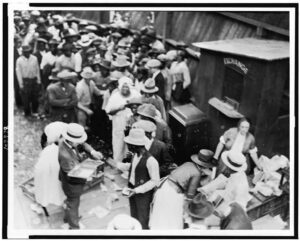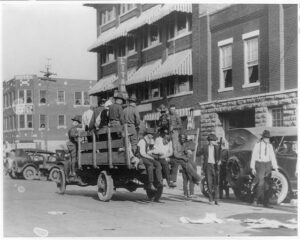Editor’s note: In commemoration of the Tulsa Race Massacre, Michigan Today is reposting this story, originally published July 18, 2019. We are so proud of Michigan alumna Maggie Yar for her research and social activism.
What’s in a name?
You know a community wants to reconcile the blood on its bootheels when some of its leaders start referring to its Race Riot as its Race Massacre.
That the community, Tulsa, Okla., is in what is commonly viewed as a red state perhaps makes the reconciling — a century after the event — all the more significant.
In the thick of the effort is Maggie Yar ’95, executive director of the Hille Foundation, an organization founded by her parents that serves low-income residents in the Tulsa area. Yar is chair of the economic development committee of the Tulsa Race Massacre Centennial Commission, which is working to educate the local community and the nation about the massacre. Her committee also is striving to spur redevelopment in “Black Wall Street,” as Tulsa’s Greenwood neighborhood was known before the massacre.
Planning now is underway to mark the centennial, which occurs in 2021.
A crash course in reality
Just how serious were the attacks on Greenwood? Below is a summary from the Tulsa Historical Society and Museum:
Don’t say a word
To get a sense of just how much Tulsa historically has tried to keep the incident quiet, Yar, a Tulsa native, didn’t learn about it until after earning her law degree from Southern Methodist University, in Dallas, in 2001.
Indeed, the commission initially used “Riot” in its own name, then changed that word to “Massacre.”
“We have never dealt with the massacre the way that we should have. We have not made it a part of our city’s fabric in the way that it should be,” Yar says.
It’s “shocking, horrifying” that the incident is not more well known, she says. “Embarrassing, personally,” she adds. “How did I not know that about the city I grew up in? And why isn’t it being taught in school, why isn’t it something that, if you’re from here and live here, that everyone knows about and talks about?”
History lesson
Republican G.T. Bynum, Tulsa’s 41-year-old mayor, is proposing the city spend $100,000 in its 2019-20 budget to search for possible mass graves from the incident.
“You had white men coming into Black Wall Street by the truckloads and literally taking people out, lining them up, and burning everything,” Yar says. “You have blocks and blocks literally burned to the ground. I mean, it was a massacre. A riot implies the two sides were fighting against each other, and that was not true.
“I don’t think that history is questioned, we’re just hiding that it happened at all.”
Yar believes her Michigan experience helped prepare her for her role as a citizen who wants to set the record straight.
“I definitely had my eyes opened; I was exposed to more differences and more points of view,” she says. “Michigan definitely taught me how to critically think and how to give a point of view and have to argue it and stand by it.”
Yar says she wants the economic development efforts she’s leading to include creating a “world-class museum or exhibit” to remember the massacre, Black Wall Street, and Greenwood.
“I don’t want this to be just a one-time event, or one thing that we just commemorate in 2021 and that’s it,” Yar says. “I’m hoping that the commission’s work will really allow it to become part of our city’s fabric.”
In Yar’s view, city and state government leaders are supportive of the centennial plans, and white residents have not been resistant. But there is a wariness among African-American residents in Tulsa about how the massacre will be remembered.
“There is a lot of hurt and a lot of anger and a lot of mistrust,” she says. “Our race relations are far from perfect; I think we have a long way to go. But is there a lot of good work going on? Yes, there have been a lot of strides.”







Charles Mason - 1969
Excellent reporting about a little known story
Reply
David Krause - 1962, 1986
Why are we told that Rowland was “a young black man” but Page only “a woman?”
Why are the “details of what followed” confined to an ellipsis? Confusing analysis.
Reply
Deborah Holdship
Good point. Sarah Page was a white elevator operator, since noted in the text. The entire summary is linked from the article if you want to read more. The Tulsa Historical Society is a great resource, as is tulsaworld.com — Ed.
Reply
Peter Rogan - 1977
What happened in Greenwood may have been a massacre, but the conditions that led to it and the result have a resonance in history. This was a pogrom. A genocidal riot with the intention of driving out or preferably killing those the general population considered a menace and an affront to their society. We saw many pogroms that meet all these characteristics in the history of late Czarist Russia. You want to use a term that is historically accurate and reflects not a past but a present and ongoing hostility and will to destroy, then you call what happened in Greenwood a pogrom.
Reply
Norman Andresen - 1976
There is a book written about the Tulsa Riot. Hirsch, James S. 2002. Riot and Remembrance. Houghton Mifflin Company, Boston. 358P. ISBN 0-618-10813-0 A very good read with a lot of research behind the text. What is very clear in the book is that the white population of Tulsa wants to keep any memory of the Riot out of the (white) public conscience. It is another event in our history that certain individuals want to keep hidden. I hope Ms Yar can bring to fruition her desire to make the Riot part of the Tulsa conscienceness.
Reply
Carmen Stokes
Please be complete in WHY this occurred. The publisher presumes the reader understands that Black Wall Street was a completely and profitable & successful ALL Black run city. The neighboring Whites were angry and jealous that Blacks could exist without them and actually be profitable. The whites burned down the city to take away their wealth and economic stability (in addition to causing extreme fear), so the Blacks would have to return to share- cropping (instead of property & business ownership) and utilizing the white stores on usury rates that were the equivalent of slavery again. A reader mentioned this is the same old story- and if you consider the death of Marcus Garvey, even Nipsey Hustle- when Blacks become powerful in leading charge to sustain themselves economically, there is always retaliation and power abuse. And it is always camouflaged in history to appear that Blacks are rowdy, unlawful, deserving if ill-fate instead of reflecting the truth. Fortunately someone cares to acknowledge it.
Reply
Leslie Hamrick
As a fellow Oklahoman, I think it is important to focus on the fact that this part of our history has been hidden. Yes, it is an ugly part, but we need to learn our history in order to not repeat it. The work being done by the Race Massacre Commission will have a great impact on the Tulsa community and Oklahoma as a whole. Tulsa is fortunate to have individuals such as Ms. Yar to lead the charge for change.
Reply
DWe Williams
Could the charge to uncover and acknowledge the
Devastation of the Tulsa massacre have been led by an Black American and still gained the respect that Ms. Yar has received?
Reply